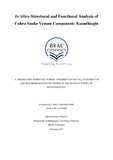| dc.contributor.advisor | Mohammad, Eusra | |
| dc.contributor.author | Khandaker, Dola | |
| dc.date.accessioned | 2017-05-07T06:25:04Z | |
| dc.date.available | 2017-05-07T06:25:04Z | |
| dc.date.copyright | 2017 | |
| dc.date.issued | 2017-02 | |
| dc.identifier.other | ID 13136009 | |
| dc.identifier.uri | http://hdl.handle.net/10361/8096 | |
| dc.description | This Thesis is submitted in partial fulfillment of the requirements for the degree of Bachelor of Science in Biotechnology, 2017. | en_US |
| dc.description | Cataloged from PDF version of thesis report. | |
| dc.description | Includes bibliographical references (page 67-70). | |
| dc.description.abstract | Snake venoms have been gaining a lot of attention in research, which has provided not only new tools to decipher molecular details of various physiological processes, but also the inspiration to design and develop many therapeutic agents, over the last few decades. Particularly, thrombosis and haemostasis are the major processes that are targeted by the snake venom proteins. Among them, anticoagulant proteins exhibit various enzymatic activities that interfere in the normal blood coagulation mechanisms. Such studies, enable us to fight unwanted clot formations and contribute to the treatment of cardiac arrests and strokes in patients with cardiovascular diseases, arteriosclerosis and hypertension. The ability of snake venom toxins to cause toxicity is associated with their high specificity and affinity for cell or tissues. This observation stimulated the development of many chemotherapeutic drugs based on snake venom toxins, which have the capacity to be highly cytotoxic. One of the targets investigated were integrins, which are cell surface receptors that play critical roles in cell adhesion and migration during cancer. A metalloproteinase, named kaouthiagin, from the venom of the snake Naja kaouthia was selected to study its structure-function relationships and mechanisms to comprehend its significance as a new anticoagulant and antagonist to integrins involved in cancer. Several in-silico tools have been used in this project to analyze the protein’s structure and function relationships. Kaouthiagin has three specific domains: Zn2+ metalloprotease, disintegrin and an ADAM-CR domain. A predicted 3D structure was elucidated for this protease. This project provides an insight to how kaouthiagin could be a potential therapeutic as an anticoagulant and anticancer agent, given that further research is performed to prove its acceptance and efficiency. | en_US |
| dc.description.statementofresponsibility | Dola Khandaker | |
| dc.format.extent | 70 pages | |
| dc.language.iso | en | en_US |
| dc.publisher | BRAC University | en_US |
| dc.rights | BRAC University thesis are protected by copyright. They may be viewed from this source for any purpose, but reproduction or distribution in any format is prohibited without written permission. | |
| dc.subject | Silico | en_US |
| dc.subject | Cobra snake venom | en_US |
| dc.subject | Kaouthiagin | en_US |
| dc.title | In silico structural and functional analysis of cobra snake venom component- Kaouthiagin | en_US |
| dc.type | Thesis | en_US |
| dc.contributor.department | Department of Mathematics and Natural Sciences, BRAC University | |
| dc.description.degree | B. Biotechnology | |

